“Back when we were flying during the surge, when we were doing [convoy] top cover [flights], you could see machine gun fire, you could see IEDs exploding,” said Capt. Ron Nolte, a C-130E navigator deployed from Little Rock AFB, Ark., to the 777th Expeditionary Airlift Squadron at Joint Base Balad in Iraq. “It was chaotic.”
Nolte went on: “Now, guys are up there for 10 hours and they’ll see maybe one [IED] go off.”
The war in Iraq, by most accounts, has turned a corner and is moving into a new phase—emphasizing institution-building more than door-kicking and munition-dropping. Bombs still explode and firefights still erupt, but the heavy fighting has subsided.
 |
The setting sun peeks out from behind the tail of a C-17 Globemaster III at Joint Base Balad, Iraq. |
Every airman in Iraq has a perspective on the changed situation. They know that, whatever happens with ground forces, the Air Force units will not be packing up and heading home anytime soon. Rather, airmen are in a countrywide mission and resource shift.
The United States is drawing down its combat forces and consolidating its bases through a process Multinational Force-Iraq officials call “shrink and share.” This is the effort to draw down US capacity in some mission areas by handing off responsibilities to the Iraqis, all the while helping build up indigenous capacity.
US forces play a key role in the transition—especially as the Iraqis take over more mission areas traditionally performed and maintained by the coalition.
“The real driver … is: What does the government of Iraq want from the coalition? ” said Maj. Gen. David E. Clary, the Air Component Coordination Element director for MNF-I in November 2008. “The Iraqis will decide how much or how little we’re going to support them,” said Clary, who for the past year has been the most senior airman based in Iraq.
The US is committed to supporting Iraq through coalition training and acquisition programs, Clary noted, but also in institution building—the process of capitalizing on the security gains made in the surge.
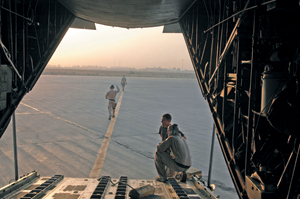 |
A1C Zachary Kelhi (kneeling) and SSgt. Tommy Greeness end a long night of delivering cargo and making airdrops over Iraq. |
The Growth of Diplomacy
Control and use of the skies is a huge part of this new phase of war. Tactical airlift is crucial in conducting government business and vital in reorienting US and Iraqi forces across the country as part of the drawdown.
“There’s always a give and take with the governance and the provinces,” Clary said. Senior Iraqi leadership, MNF-I officials, and local leaders must often go out and work local governance issues face-to-face, especially where “sectarian issues” remain at play.
Airlift is also critical in facilitating the growth of diplomacy with Iraq’s neighbors in the Gulf region, as they restore and solidify the country’s regional ties.
With the raging insurgency now in the rearview mirror, Clary conceded, outsiders might have trouble seeing an immediate need for airpower.
“We’re not as well-versed or understood by the public or some in the service about COIN [counterinsurgency],” he said. “Airmen are doing nontraditional things in this fight, and individuals who belong to the joint organizations are making significant contributions to this campaign.”
With about 145,000 combat troops remaining in Iraq, a good portion of US Central Command’s aviation sorties is dedicated to sustainment. In early January, about 130 mobility missions were flown every day to restock and resupply the US forces around Iraq.
As the US and coalition posture slowly changes course, a large chunk of activity is playing out at Sather Air Base and the sprawling Victory Base Complex (VBC) in Baghdad.
Sather was named in honor of SSgt. Scott D. Sather—an Air Force combat controller who was killed in Iraq in 2003. Sather is the home of the 447th Air Expeditionary Group, a component of the VBC, which surrounds Baghdad Airport. VBC is home to the headquarters of Multinational Force-Iraq and several other camps and logistics hubs, such as Camp Stryker, Camp Slayer, and Camp Liberty.
Col. David P. Pavey, commander of the 447th AEG in November, said the USAF presence at Sather should remain constant as it plays a large role in the shifting of combat power in country. The 447th Air Expeditionary Group runs the aerial port operations, command and control of the military runway at the airport, medical support, and aerial control at Sather.
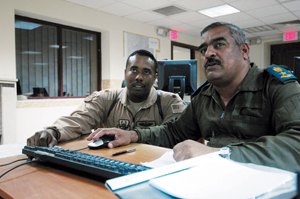 |
Maj. Kingston Lampley (l) advises an Iraqi airman as part of USAF’s military transition team at Camp Victory, Iraq. |
A Split Facility
The airport’s civilian runway operates on the east side, along with the terminal used for Baghdad’s international civil flights.
After Balad, Sather is the Air Force’s primary in-country hub—seeing approximately 1,000 personnel transition through its ramp on any given day.
“We’re the No. 1 mover of people in Iraq,” Pavey, a Reservist deployed from the 446th Operations Group at McChord AFB, Wash., said.
Many of the locally based US units are decreasing in size or shifting outside the country, he said. The result of the shrink and share effort means many old missions will end and be handed off to Iraqi units as they manage more properties.
“Our job is to make sure [the materiel] keeps flowing,” Pavey added. “If we lose a pallet, in this day and age, it’s a big deal. If we find a way of getting a pallet to a warfighter sooner or more expeditiously, we just helped win the war.”
Many of the units and functions previously headquartered in the International Zone will transition to the VBC. The 447th AEG’s relationship with the commander of New Al Muthana Air Base, down the street from Sather, is important. The two installations share taxiways and conduct joint exercises.
At the end of 2008, 14 airfield facilities across Iraq were controlled and operated by coalition forces. The Iraqi Air Force is in the midst of a large buildup, and will be expanding operations beyond the bases it currently utilizes at Kirkuk, Basra, Taji, and New Al Muthana.
“There will be more of them and eventually less of us,” Pavey noted. The IqAF is considering future use and development at Al Asad, Ali, Balad, Al Kut, and Suwayrah, among others, as part of the transition.
On New Year’s Day, a significant transition occurred as the International Zone, commonly known as the Green Zone, was formally handed over to the Iraqi government.
The long-awaited status of forces agreement (SOFA) between the US and Iraq, first signed in late 2008, faces a nationwide referendum by the end of July. If ratified, most combat troops will be withdrawn by the end of 2011.
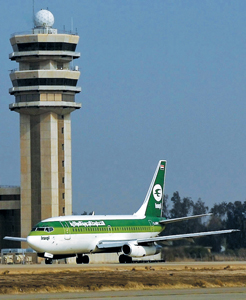 |
An Iraqi 737-200 taxis at Baghdad Airport. The airport’s civilian runway operates on the east side. |
This already affects US and coalition air operations across Iraq, as the new status of forces rules are now in effect.
In November, Clary’s office was tracking the agreement’s evolution. The SOFA will define both the duration and nature of the US presence in Iraq. “That will change the whole nature of coalition support and, in turn, air support,” he said. “There will be ramifications for all.”
Still, coalition operations were proceeding with few large roadblocks. As the agreement stands, the US and Iraq are undergoing a two-phase transition of Iraqi sovereignty of its airspace from the coalition to Iraqi civil and military authorities. According to MNF-I statements and documents, the first will be achieved early this year.
Phase 1 moves include: approval of an implementation plan by the Iraqi civil aviation authorities and the IqAF; partial transfer of aeronautical information system functions from the combined force air component commander; and development of an agreement between the CFACC and the Iraqis, defining coordination and delegation of airspace.
As of Jan. 1, the Iraqis officially gained sovereignty of their airspace above 24,000 feet. Airmen with the 447th AEG are part of this transition, as its controllers supervise the tower at Baghdad Airport, Pavey said. “The day-to-day operations of the tower [are] run by Iraqis, but US advisors are with them,” he said.
According to Clary’s office, coalition air assets using airspace above 24,000 feet coordinate with Iraqi air traffic controllers to transit that area. The Iraqis have, however, requested that the US continue to control airspace at or below 24,000 feet until Iraq’s capabilities “mature.”
There will therefore be no noticeable effect on air operations below 24,000 feet—a key factor in conducting a range of US operations from aeromedical evacuation to close air support for troops in the field.
“There has been no significant impact to coalition use of airspace or air operations since implementation of the security agreement,” MNF-I confirmed in a January statement. Previously established coordination procedures also help ensure that unmanned aerial vehicle operations continue unhindered.
The procedures governing air strikes are unchanged, as US air traffic control liaisons are positioned with Iraqi air controllers to ensure airspace is clear before conducting a strike.
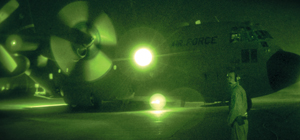 |
A1C Delmar Karnes keeps a sharp eye out as a C-130 warms up its engines on the flight line at Baghdad Airport. |
Looking Toward Phase 2
New rules of engagement are being coordinated with the Iraqis, according to MNF-I, but details are not released for security reasons. “US forces, as always, retain the right of self-defense,” MNF-I officials said.
Phase 2 of the airspace transition will focus on long-term development of the Iraqi Civil Aviation Authority, to gain compliance with the International Civil Aviation Organization, Clary said. This requires work on management and oversight, infrastructure development, improved communication, navigation and surveillance upgrades, and creating a trained workforce of air traffic controllers.
“The military flavor of this place is shifting to a much more standardized operation,” Pavey said of the process at Baghdad Airport. The threats have declined, and as the airport becomes more like a regular international airport, US forces are facilitating the flow of civilian passengers.
A small building next to Air Force House in the VBC—where the Iraqi air operations center is located—will become the focal point for deconflicting Iraqi military and civilian airspace.
Gen. Wamid Lutfy, commander of the Iraqi air operations center, said his country is divided into four air defense sectors, each of which is overseen in a small room with 10 workstations, using basic VHF/UHF technology, cell phones, and Internet chat.
Operating since March 2007, the AOC complies with a master plan from the Ministry of Defense and the IqAF. The operations center tracks and controls most Iraqi military air traffic in country and deconflicts civil traffic. Schedules, flight patterns, and sorties are coordinated with MNF-I headquarters and the combined air operations center.
“We are working with new technology, but this takes time and people,” Lutfy said.
Iraqi control over 24,000 feet effectively doubles national responsibilities, and US and coalition forces have seen the demand for coalition controllers at Baghdad and Basra airport towers nearly halved.
Results of the transition are already apparent. Insurance rates for civilian carriers dropped in half over the previous six months.
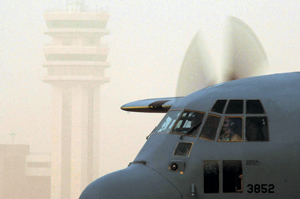 |
A C-130 taxis on the flight line during a dust storm at Sather AB, Iraq. Sather is located on the west side of Baghdad Airport. (USAF photo by TSgt. Jeffrey Allen) |
Security First
“As security continues to improve, nationally flagged carriers will be more inclined to come here,” said Clary in November. The MNF-I Air Component Coordination Element staff helped brief insurers in London late last year, working with the US Embassy.
These seemingly bureaucratic details reveal the fruits of the US and coalition efforts in Iraq. “Security is important [and] it is the foundation of the other lines of operation,” Clary said. “The growth of the Iraqi economy, the growth of government— … if security is good, we can do those things.”
Capt. Steve DeHaas, a veteran C-130 flight commander who flew US missions and worked as a training advisor with the IqAF during the surge, said his experiences with his Iraqi counterparts were a clear indication that the country was becoming safer.
The Iraqis were the ones who told him something was working, he recalled. On his first deployment to Baghdad, “we were getting mortared all the time; there were attacks downtown. … One of our loadmasters was murdered by a death squad in broad daylight.
“By the time I left,” DeHaas continued, “they were shopping with their families, going out to eat. … That’s when I knew.”
As large units roll through the VBC and the Iraqi infrastructure improves, the work of airmen at Baghdad Airport and Sather will remain fluid.
Pavey’s assessment of the situation reflects a snapshot of the mood of airmen across Iraq, as the six-year anniversary of the conflict approaches. From security forces walking patrols outside the wire to loadmasters on ramps across the country, there is a general sense of progress. Nobody is celebrating yet, and most are very realistic about the hard work remaining—and how long it will take.
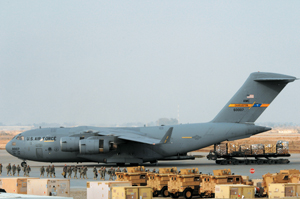 |
USAF airmen unload pallets of cargo from a C-17 at Sather AB, Iraq, as airmen file in front of the airlifter. |
“This is a living thing,” Pavey said, reminiscent of earlier missions in his career. In short, he believes the airmen on the ramp will be among the last to leave. “I’ve done other contingencies in the last 20 years, … and pretty much the last airplane out is the C-130 with a loadmaster climbing up the ramp on the way out,” he concluded.